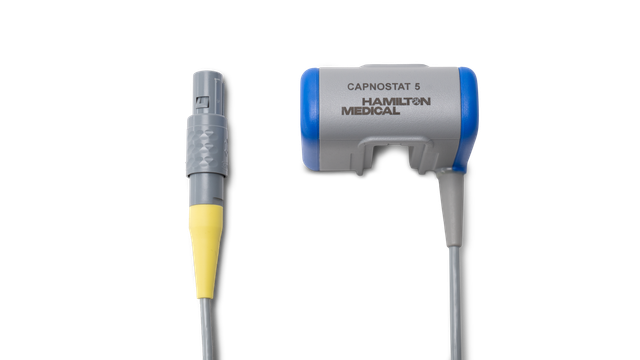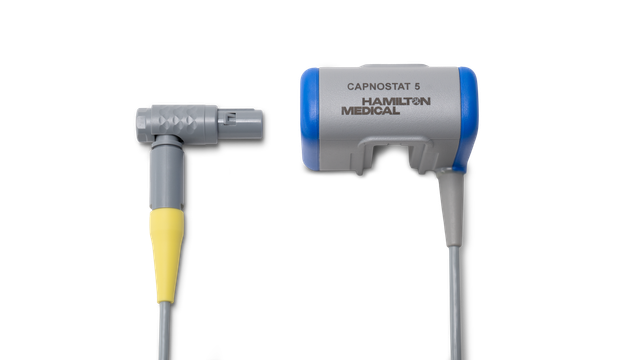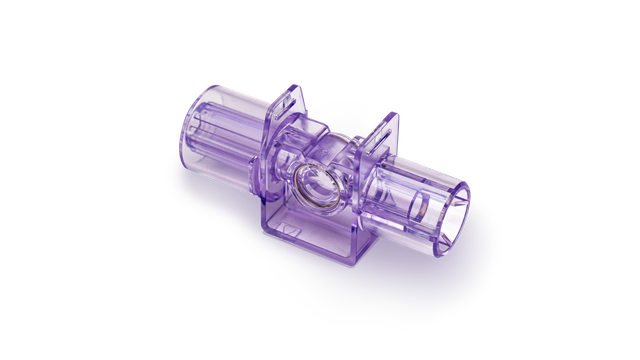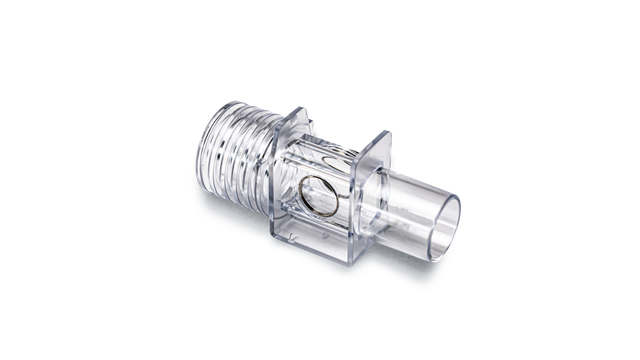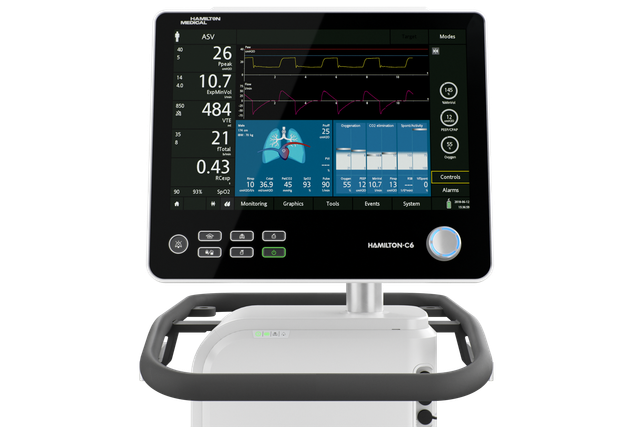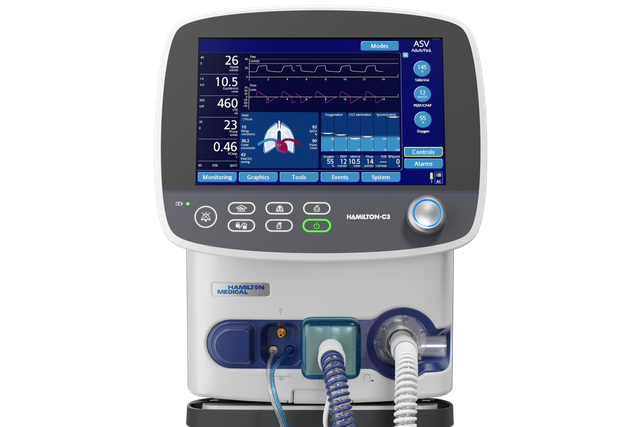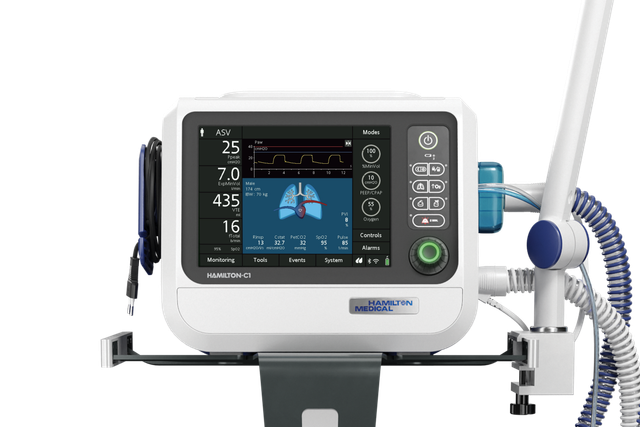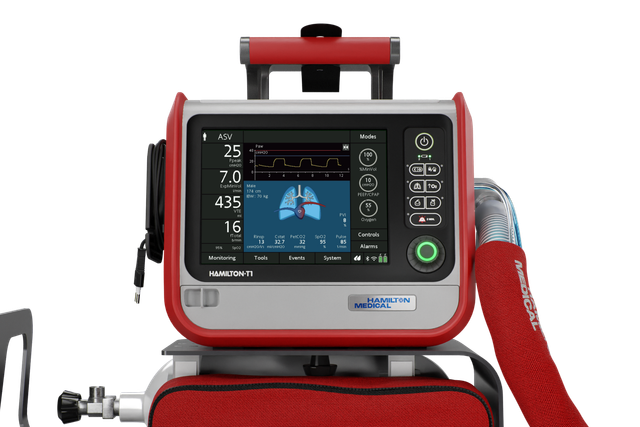
Más información. Monitorización del CO2 volumétrico
Las fases de un capnograma volumétrico, la forma y morfología de la curva, así como las mediciones obtenidas de los cálculos, pueden arrojar información importante sobre los siguientes aspectos:
- Eficacia de la relación ventilación‑perfusión
- Fracción del espacio muerto fisiológico
- Tasa metabólica del paciente (
Jaffe MB. Using the features of the time and volumetric capnogram for classification and prediction. J Clin Monit Comput. 2017;31(1):19‑41. doi:10.1007/s10877‑016‑9830‑z1 )
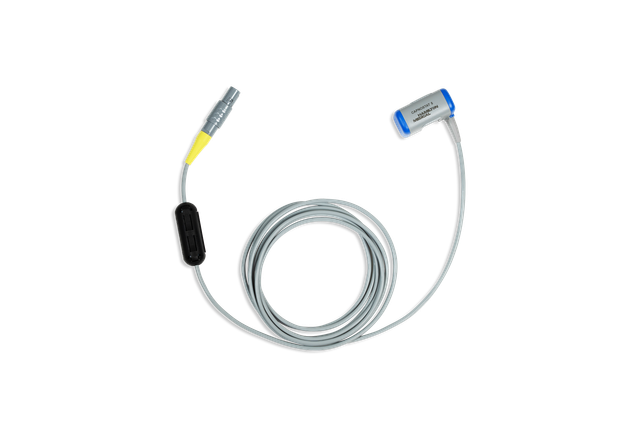
Una potente herramienta. Sensor de CO2
En nuestros respiradores, el CO2 se mide con un sensor de flujo de CO2 CAPNOSTAT‑5 proximal a la vía aérea del paciente.
El sensor CAPNOSTAT‑5 proporciona mediciones precisas del dióxido de carbono al final del volumen tidal (PetCO2), así como un capnograma claro y preciso en todas las frecuencias respiratorias de hasta 150 respiraciones por minuto.
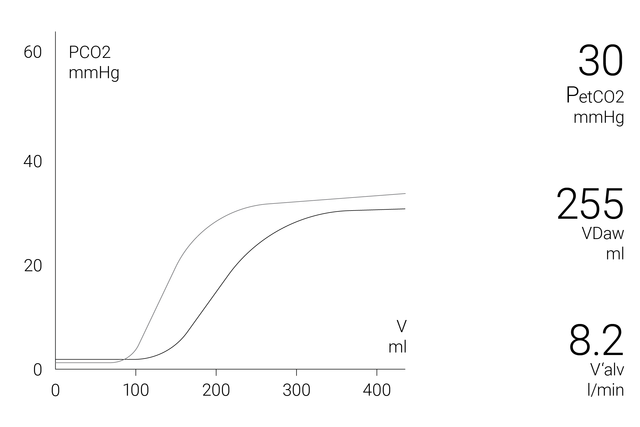
Sensor pequeño, grandes datos. Esto es lo que ofrece
La ventana del capnograma volumétrico en la pantalla muestra información cuantitativa exacta como una combinación de los datos de CO2 proximal y flujo proximal, entre los que se incluyen:
- Curva de capnograma volumétrico actual
- Curva de referencia de capnograma volumétrico
- Botón de curva de referencia con hora y fecha de bucle de referencia
- Valores de CO2 más significativos, por respiración
Permite un análisis más completo del estado del paciente, una tendencia de 72 horas (o de 96 horas para el HAMILTON‑G5/S1) de los siguientes parámetros:
- PetCO2
- V‘CO2
- FetCO2
- VeCO2
- ViCO2
- Vtalv
- V'alv
- VDaw
- VD/Vt
- VDaw/VTE
- Pend.CO2
A fin de simplificarle las cosas, los respiradores de Hamilton Medical ofrecen una visión general de todos los valores de CO2 pertinentes en la ventana Monitorización de CO2.
- Concentración de CO2 fraccional al final del volumen tidal: FetCO2 (%)
- Presión de CO2 al final del volumen tidal: PetCO2 (mmHg)
- Pendiente de la meseta alveolar en la curva de PetCO2, que indica el estado de la relación volumen/flujo en los pulmones: pend.CO2 (%CO2/l)
- Ventilación tidal alveolar: Vtalv (ml)
- Ventilación minuto alveolar: V’alv (l/min)
- Eliminación CO2: V’CO2 (ml/min)
- Espacio muerto en la vía aérea: VDaw (ml)
- Fracción de espacio muerto en la vía aérea en la apertura de la vía aérea: VDaw/VTE (%)
- Volumen de CO2 espirado: VeCO2 (ml)
- Volumen de CO2 inspirado: ViCO2 (ml)
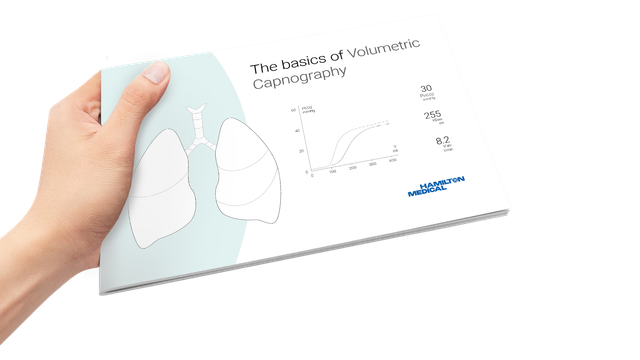
Libro electrónico gratuito
¡Siga aprendiendo! Todo sobre la capnografía volumétrica
Aprenda a interpretar capnogramas volumétricos y obtenga una visión general de las ventajas y las aplicaciones clínicas de la capnografía volumétrica. Incluye una prueba de autoevaluación.
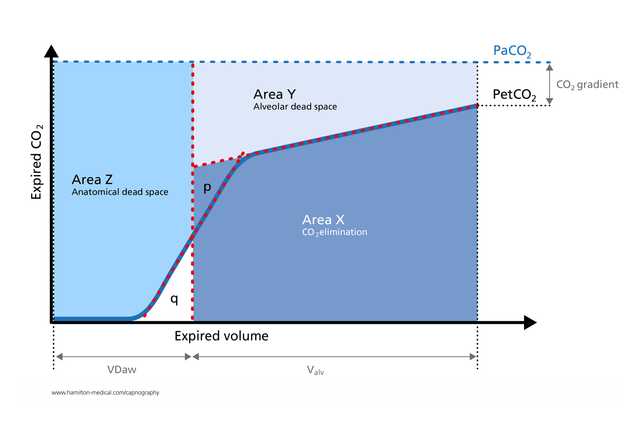
¿Cuáles son las ventajas? Examinemos las pruebas
El capnograma volumétrico se ha utilizado con éxito en la medición del espacio muerto anatómico, la perfusión capilar pulmonar y la eficiencia ventilatoria (
Romero PV, Lucangelo U, Lopez Aguilar J, Fernandez R, Blanch L. Physiologically based indices of volumetric capnography in patients receiving mechanical ventilation. Eur Respir J. 1997;10(6):1309‑1315. doi:10.1183/09031936.97.100613092 )Los cálculos procedentes del capnograma volumétrico resultan útiles para identificar la embolia pulmonar a pie de cama (
Blanch L, Romero PV, Lucangelo U. Volumetric capnography in the mechanically ventilated patient. Minerva Anestesiol. 2006;72(6):577‑585. 3 )En un estudio de pacientes con SDRA con ventilación mecánica, las mediciones de la capnografía volumétrica de la relación fisiológica existente entre el espacio muerto anatómico y el volumen tidal son igual de precisas que las obtenidas mediante la técnica de monitorización metabólica (
Kallet RH, Daniel BM, Garcia O, Matthay MA. Accuracy of physiologic dead space measurements in patients with acute respiratory distress syndrome using volumetric capnography: comparison with the metabolic monitor method. Respir Care. 2005;50(4):462‑467. 4 )El capnograma espiratorio es una medición no invasiva, rápida e independiente del esfuerzo que ayuda a detectar broncoespamos significativos en pacientes adultos con asma (
Yaron M, Padyk P, Hutsinpiller M, Cairns CB. Utility of the expiratory capnogram in the assessment of bronchospasm. Ann Emerg Med. 1996;28(4):403‑407. doi:10.1016/s0196‑0644(96)70005‑75 )Al ofrecer información valiosa sobre la fisiología del reclutamiento y colapso pulmonares de forma no invasiva y en tiempo real, la capnografía volumétrica permite monitorizar las maniobras de reclutamiento cíclico a pie de cama (
Tusman G, Suarez‑Sipmann F, Böhm SH, et al. Monitoring dead space during recruitment and PEEP titration in an experimental model. Intensive Care Med. 2006;32(11):1863‑1871. doi:10.1007/s00134‑006‑0371‑76 )

¡Siga aprendiendo! Recursos de formación sobre capnografía volumétrica
Accesorios y material fungible
Ofrecemos material fungible original para pacientes adultos, pediátricos y neonatos. Puede elegir entre productos reutilizables o desechables, en función de las políticas de su centro sanitario.
Disponibilidad
La capnografía volumétrica está disponible de forma opcional para el HAMILTON‑C6, el HAMILTON‑G5, el HAMILTON‑C3 y el HAMILTON‑C1/T1, y se incluye de serie en el HAMILTON‑S1.
Referencias
- 1. Jaffe MB. Using the features of the time and volumetric capnogram for classification and prediction. J Clin Monit Comput. 2017;31(1):19‑41. doi:10.1007/s10877‑016‑9830‑z
- 2. Romero PV, Lucangelo U, Lopez Aguilar J, Fernandez R, Blanch L. Physiologically based indices of volumetric capnography in patients receiving mechanical ventilation. Eur Respir J. 1997;10(6):1309‑1315. doi:10.1183/09031936.97.10061309
- 3. Blanch L, Romero PV, Lucangelo U. Volumetric capnography in the mechanically ventilated patient. Minerva Anestesiol. 2006;72(6):577‑585.
- 4. Kallet RH, Daniel BM, Garcia O, Matthay MA. Accuracy of physiologic dead space measurements in patients with acute respiratory distress syndrome using volumetric capnography: comparison with the metabolic monitor method. Respir Care. 2005;50(4):462‑467.
- 5. Yaron M, Padyk P, Hutsinpiller M, Cairns CB. Utility of the expiratory capnogram in the assessment of bronchospasm. Ann Emerg Med. 1996;28(4):403‑407. doi:10.1016/s0196‑0644(96)70005‑7
- 6. Tusman G, Suarez‑Sipmann F, Böhm SH, et al. Monitoring dead space during recruitment and PEEP titration in an experimental model. Intensive Care Med. 2006;32(11):1863‑1871. doi:10.1007/s00134‑006‑0371‑7


